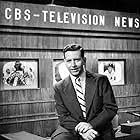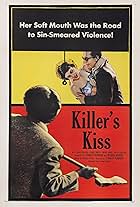IMDb RATING
6.2/10
5.4K
YOUR RATING
After a short study of boxing's history, narrated by newscaster Douglas Edwards, we follow a day in the life of a middleweight Irish boxer named Walter Cartier.After a short study of boxing's history, narrated by newscaster Douglas Edwards, we follow a day in the life of a middleweight Irish boxer named Walter Cartier.After a short study of boxing's history, narrated by newscaster Douglas Edwards, we follow a day in the life of a middleweight Irish boxer named Walter Cartier.
Judy Singer
- Self - Female Fan in Crowd
- (uncredited)
- Director
- Writer
- All cast & crew
- Production, box office & more at IMDbPro
Featured reviews
Day of the Fight (1951)
*** (out of 4)
Kubrick's second short shows us a day in the life of a middle-weight boxer as he prepares for a fight. Even with the boring narration, this film here moves a lot better and the fight scene is rather interesting because it's shown complete as it happened. You can spot Kubrick in a few scenes with his camera.
Flying Padre (1951)
** (out of 4)
Stanley Kubrick's first film is a documentary about a priest in New Mexico who needs a plane to keep up with all his people. This is a really boring and flat film even with its 9 minute running time. The priest really isn't that interesting and the narration is flat and stiff. God knows better things were to follow from Kubrick.
Seafarers, The (1953)
** (out of 4)
Overly long and dreadfully boring promotional film for the Seafarers Union, which basically tries to teach people why they should join. This is historically interesting only because it's Stanely Kubrick's first film in color. The rest is pure boredom and it's no wonder Kubrick doesn't want this film seeing the light of day.
*** (out of 4)
Kubrick's second short shows us a day in the life of a middle-weight boxer as he prepares for a fight. Even with the boring narration, this film here moves a lot better and the fight scene is rather interesting because it's shown complete as it happened. You can spot Kubrick in a few scenes with his camera.
Flying Padre (1951)
** (out of 4)
Stanley Kubrick's first film is a documentary about a priest in New Mexico who needs a plane to keep up with all his people. This is a really boring and flat film even with its 9 minute running time. The priest really isn't that interesting and the narration is flat and stiff. God knows better things were to follow from Kubrick.
Seafarers, The (1953)
** (out of 4)
Overly long and dreadfully boring promotional film for the Seafarers Union, which basically tries to teach people why they should join. This is historically interesting only because it's Stanely Kubrick's first film in color. The rest is pure boredom and it's no wonder Kubrick doesn't want this film seeing the light of day.
It's always interesting to go back to the beginning of a director's career, in this case Stanley Kubrick's, and take a look at his earlier work. Day of the Fight just happens to be the first film by now legendary director Kubrick who is widely regarded as one of the best contemporary directors ever. This film is around about 15-20 minutes long and revolves around the build up to a boxing match the study of the build up will revolve around.
Interestingly enough and perhaps the most interesting thing about it is that it was inspired by a photograph Kubrick himself took for a 1949 edition of a magazine. This could be seen as an early example of suspense, with constant reference to the boxing match and its importance made through narrator Douglas Edwards, a good casting for the serious and deep voice the film required. As a short, it works and the suspense and build up maintains some sort of interest as the montage plays out. Kubrick includes all sorts of shots and angles creating the nice range for the eye, my favourite being the low angle on the statue of Mary in the church about half way through.
But the focus could well be the fight itself. There is some good camera work to be had out of the actual match and a low angle between a boxer's legs would later be used by Kubrick in Killer's Kiss, another early Kubrick film. I actually would have liked the boxing match's result to have been the other way around as I feel it would've added a new dimension to the short, a sort of anti-climatic spin that might've worked well. But that said, it's worth seeing if for the match itself and the chance to see where it all started off for the great man.
Interestingly enough and perhaps the most interesting thing about it is that it was inspired by a photograph Kubrick himself took for a 1949 edition of a magazine. This could be seen as an early example of suspense, with constant reference to the boxing match and its importance made through narrator Douglas Edwards, a good casting for the serious and deep voice the film required. As a short, it works and the suspense and build up maintains some sort of interest as the montage plays out. Kubrick includes all sorts of shots and angles creating the nice range for the eye, my favourite being the low angle on the statue of Mary in the church about half way through.
But the focus could well be the fight itself. There is some good camera work to be had out of the actual match and a low angle between a boxer's legs would later be used by Kubrick in Killer's Kiss, another early Kubrick film. I actually would have liked the boxing match's result to have been the other way around as I feel it would've added a new dimension to the short, a sort of anti-climatic spin that might've worked well. But that said, it's worth seeing if for the match itself and the chance to see where it all started off for the great man.
Very interesting documentary short by Kubrick, "The Day of the Fight" (1951) showcases Kubrick's unmatched (apart only from Tarkovsky's) eye for film making and photography.
To think that a 23 year-old Stanley Kubrick laid that groundwork inspiring Martin Scorsese's masterpiece, "Raging Bull" (1980) in terms of both theme and most certainly cinematography, is truly astounding. Stanley Kubrick truly was unmatched amongst his previous and future peers of American cinema.
To think that a 23 year-old Stanley Kubrick laid that groundwork inspiring Martin Scorsese's masterpiece, "Raging Bull" (1980) in terms of both theme and most certainly cinematography, is truly astounding. Stanley Kubrick truly was unmatched amongst his previous and future peers of American cinema.
Stanley Kubrick was never one for realistic films about ordinary people; the nearest he came to a straightforward drama was probably the heist movie, The Killing. This shying away from realism seems to show itself in his very first film, this short documentary about the boxer, Walter Cartier, preparing for and engaging in a fight. Any boxer is a special person, but some directors might have portrayed Cartier as a regular guy with a particular skill; but from the start Kubrick stresses Cartier's unusualness by showing waking up beside, and going around town with, his identical twin brother, giving a surreal aspect to the film.
The way Cartier psychs himself up for the fight in his dressing room, turning himself into a fighting machine, also seems to fit in with Kubrick's later interest in making films about people under stress (eg Full Metal Jacket) or in an abnormal state (eg The Shining and Clockwork Orange). It is also intriguing to wonder whether the director's fondness for voiceover narrative in his feature films stems from this and his other early documentaries. Oh, by the way, it's quite a good documentary about a fighter who, in fact, never became champ, and went into TV and films.
The way Cartier psychs himself up for the fight in his dressing room, turning himself into a fighting machine, also seems to fit in with Kubrick's later interest in making films about people under stress (eg Full Metal Jacket) or in an abnormal state (eg The Shining and Clockwork Orange). It is also intriguing to wonder whether the director's fondness for voiceover narrative in his feature films stems from this and his other early documentaries. Oh, by the way, it's quite a good documentary about a fighter who, in fact, never became champ, and went into TV and films.
The first short film by Kubrick, it follows a boxer through the day-long wait for an evening fight.
I watched this out of interest as I watch the majority of Kubrick's films. However this is the only appeal that I can see for watching this.
The short follows the boxer through his routines on the day, the heavy narration talks us through the whole thing. In theory the short is meant to give us an insight in the boxer's thoughts and feelings however it really only shows us what he eats and who he talks to.
This is interesting if you are a Kubrick completist but other than that it is of limited appeal.
I watched this out of interest as I watch the majority of Kubrick's films. However this is the only appeal that I can see for watching this.
The short follows the boxer through his routines on the day, the heavy narration talks us through the whole thing. In theory the short is meant to give us an insight in the boxer's thoughts and feelings however it really only shows us what he eats and who he talks to.
This is interesting if you are a Kubrick completist but other than that it is of limited appeal.
Storyline
Did you know
- TriviaIt cost Stanley Kubrick $3,900 to make and he sold it (to RKO) for $4,000.
- Alternate versionsWhen RKO obtained the film for their "This Is America" series, they added about four minutes of new material to the beginning of the film, making the short 16 minutes long instead of the original 12 minutes. The opening four minutes with boxing historian Nat Fleischer is markedly different from the rest of the film as if features footage from different boxing matches. The opening was also modified with the credits appearing in different order and the music for the opening was also changed. The majority of the picture is the same until the end. In the last sequence when the knock out happens, the narration is once again changes. Kubrick's original cut features Douglas Edwards talking about personal sacrifice and success. The extended RKO cut removes this portion of the narration and adds new one with Nat Fleischer to better match the opening segment - this narration is about how this fight will go down into the record books. The music at the end was also changed - Gerald Fried's finale cue was moved earlier to match the beginning of the new narration, but because it starts sooner, it doesn't line up with the ending. Thus the new end title card (which adds This is America to the bottom of the card) plays in silence.
- ConnectionsFeatured in The Art of Stanley Kubrick: From Short Films to Strangelove (2000)
Details
- Release date
- Country of origin
- Language
- Also known as
- Day of the fight (Día de combate)
- Filming locations
- Church of St. Francis Xavier, 46 W. 16th St., New York City, New York, USA(Church where Walter Cartier and his brother, Vincent, attend morning mass)
- Production company
- See more company credits at IMDbPro
Box office
- Budget
- $3,900 (estimated)
- Runtime16 minutes
- Color
- Aspect ratio
- 1.37 : 1
Contribute to this page
Suggest an edit or add missing content























